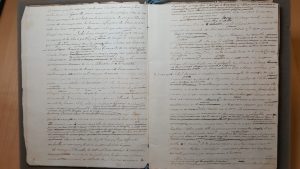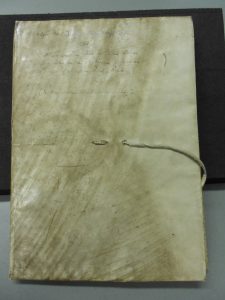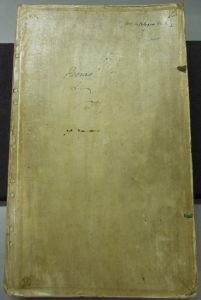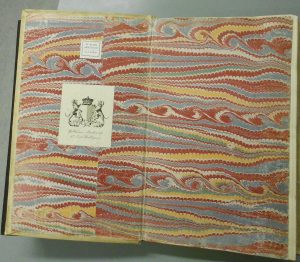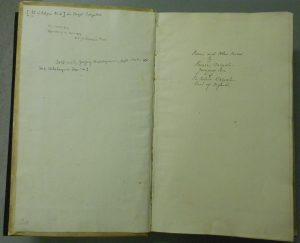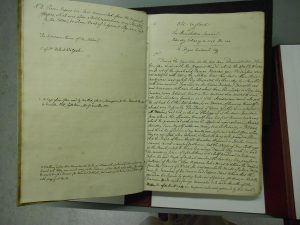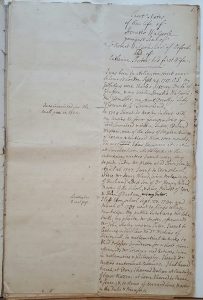King Louis XVI’s Translation of Horace Walpole’s Historic Doubts
by Loftus Jestin, Professor Emeritus of English, Central Connecticut State University
Among the curious artifacts at the Lewis Walpole Library, one of the truly rare and startling manuscripts is Louis XVI’s translation of Historic Doubts on the Life and Reign of King Richard III.
The original publication in 1768 of Horace Walpole’s attempt to exonerate the reputation of Richard III caused quite a stir. The book generated much controversy with rebuttals and vilifications by such luminaries as Hume and Gibbon, many of which Walpole answered tartly over the next twenty years or so. William Cole and Thomas Gray affirmed Walpole’s argument, as, in fact, did Voltaire. The execution of the French king on January 21st, 1793, so upset Walpole that he wrote an angry, vituperative letter eight days later of nearly a thousand words to Lady Ossory, in which he could find no terms sufficiently strong to describe the murderers: “It remained for the enlightened eighteenth century to baffle language and invent horrors that can be found in no vocabulary” [Corres., p. 177, vol. 34, 1965]. The death of this “best-natured and most inoffensive of men” [p. 176], not to forget his reputation, which was so thoroughly traduced by the revolutionary mob, seemed to him a parallel to, if not a vindication of, his assertion in Historic Doubts that Richard III was maligned and his name thoroughly blackened by Lancastrian and Tudor propagandists.
It would have heartened Walpole had he known of the French king’s translation of the book before he died in 1797. Apparently, having been purloined by the mob from the king’s cell at the Tuileries, the manuscript escaped destruction and ended up in the hands of the publisher Roussel d’Epinol, who printed it at his shop in Paris in 1800. The manuscript was then purchased by Louise Comtesse de Ponthon, who married Henry Seymour; it descended down the generations of the Seymour family until its sale in 1949 at Sotheby’s to Dr. James Hasson of Berkshire for £300, who then sold it through Maggs Bros. Ltd. in 1950 to Wilmarth S. Lewis for £350. The manuscript remains in the Lewis Walpole Library, Farmington, Connecticut.
It appears from the manuscript that the king wrote out his translation in an already bound notebook of 82 octavo-sized pages, rather than on loose sheets. Written in a tiny and very neat cursive hand over each side of each leaf, the script forms a continuous, uninterrupted flow, albeit in a slightly cramped hand. There are many cross outs and corrections, especially in the early part of the text, but with far fewer emendations in the latter half, suggestive of a greater confidence, or perhaps, more alarmingly, of the need for speed, given the king’s awareness of his approaching doom.
Many years ago, Mr. Lewis told me the following anecdote, which I have not been able to confirm. Not long after his purchase of the manuscript, authorities at the Bibliothèque nationale informed him that his manuscript was only a copy of the original, which was housed there in Paris. “Not at all,” Mr. Lewis rebutted. “You have the copy. The original manuscript in the king’s hand is here in Farmington. Come and see it for yourself!” No doubt annoyed by this pesky American millionaire, the French national library sent two experts to examine the manuscript. “Quite supercilious they were, too!” Lewis testified, until they held his copy in hand, whereupon one of the men had to sit down, quite faint. There was no question who had the original, and who the copy.
Twenty years ago or so, I used to take my graduate students on a field trip to the Lewis Walpole library to look at some the rare books there, books they had read in modern editions for my seminar on eighteenth-century literature. Pope’s own copy of Homer’s Odyssey with his pencil drawing of his grotto at his house in Twickenham on the inside of the back cover, volumes of the original publications of many seventeenth and eighteenth-century plays, Bentley’s hand-drawn illustrations for Gray’s poems, the second folio of Shakespeare’s plays, and other such treasures. When I opened for them the slip case holding Louis XVI’s manuscript translation of Historic Doubts, many of the students gasped and looked at each other bug-eyed with a wild surprise, having never seen such an astonishing rarity before.



